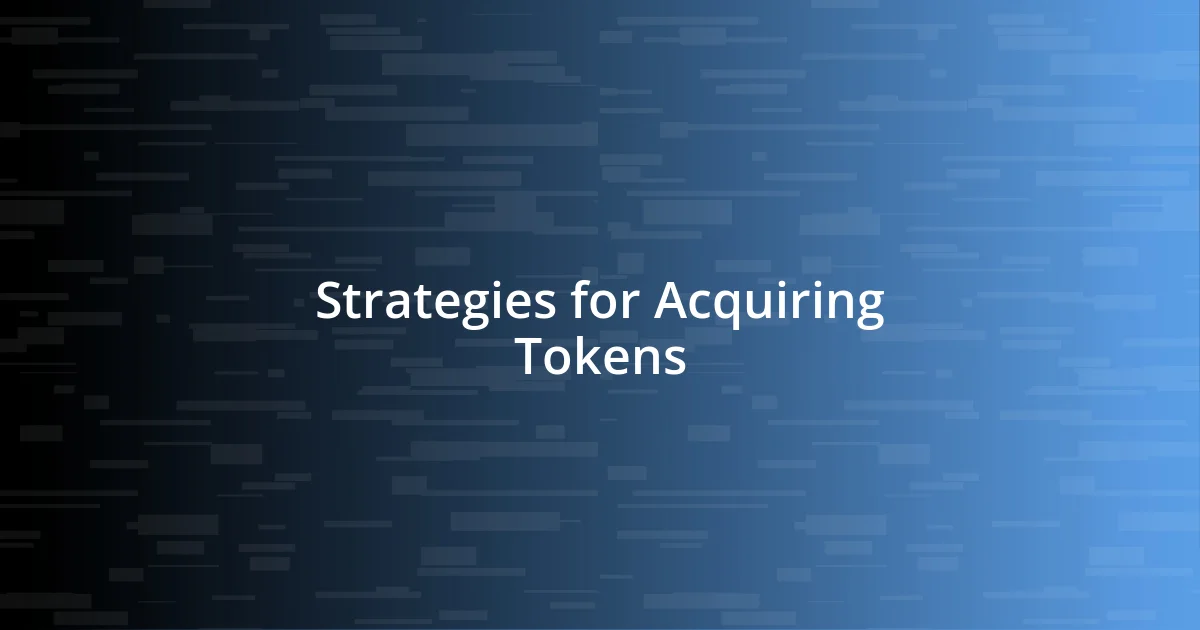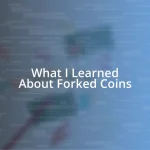Key takeaways:
- Collectible tokens, particularly NFTs, offer unique ownership experiences tied to digital assets, supported by blockchain technology for security and provenance.
- Evaluating token value involves analyzing factors like rarity, provenance, market demand, utility, and historical performance for informed decision-making.
- Effective token management and acquisition strategies include utilizing community connections, patiently monitoring market trends, and securing tokens with hardware wallets for safety.

Understanding Collectible Tokens
Collectible tokens are digital assets often linked to a specific piece of content, like art, music, or even virtual items in games. When I first stumbled upon the world of collectible tokens, I felt an instant jolt of excitement—could these little pieces of code really hold value? It was fascinating to realize that each token is unique, creating a sense of rarity and ownership that traditional collectibles strive for yet can be easily replicated.
As I explored deeper, I learned that these tokens often utilize blockchain technology, which ensures their provenance and security. I remember feeling a sense of wonder when I purchased my first token; the thrill of owning something that belonged purely in the digital realm was exhilarating. It made me think: what does ownership truly mean when it’s no longer tied to physical items?
Moreover, the emotional connection to collectible tokens can be incredibly strong, as they often represent more than just a digital item. For example, acquiring a token that symbolizes a favorite game or a beloved artist can evoke cherished memories. Have you ever had a moment where a physical collectible reminded you of a fond experience? The beauty of these digital tokens is that they can encapsulate those same emotions in an innovative way.

Types of Collectible Tokens
When diving into the world of collectible tokens, it’s essential to understand the different types available. The most common types include Non-Fungible Tokens (NFTs), which represent unique digital assets, and Fungible Tokens, which can be exchanged on a one-to-one basis, much like cryptocurrencies. I recall my excitement when I first bought an NFT; the uniqueness of owning a digital artwork from my favorite creator left me intrigued by the endless possibilities this technology presents.
Then we have utility tokens, which provide access to a specific service or functionality within a platform. They’ve gained attention for their practical applications, like voting rights in a crypto community or exclusive access to events. It’s fascinating how utility tokens can blend ownership and participation, making me feel like I’m part of something larger, rather than just a collector on the sidelines.
Lastly, there are security tokens that represent ownership in real-world assets, like shares in a company or real estate. I often think about the implications of this tokenization—bringing liquidity to traditionally illiquid assets opens up a world of investment opportunities. Can you imagine owning a fraction of a historic property through a token? It’s an exhilarating thought and showcases the diverse landscape of collectible tokens.
| Type | Description |
|---|---|
| Non-Fungible Tokens (NFTs) | Unique digital assets often tied to art, music, or games. |
| Fungible Tokens | Interchangeable tokens like cryptocurrencies, which hold equal value. |
| Utility Tokens | Tokens providing access to services or products on a specific platform. |
| Security Tokens | Tokens representing ownership of real-world assets. |

How to Evaluate Token Value
Evaluating token value requires a blend of emotional resonance and analytical skills. Personally, I’ve found that truly understanding a token’s worth goes beyond numbers; it’s about the story behind the token. For instance, I once stumbled upon a gaming item token that immediately brought back memories of late-night gaming sessions with friends. That emotional connection made me realize how nostalgia could significantly enhance a token’s perceived value.
To ensure that you’re making informed decisions when evaluating token value, consider these key factors:
- Rarity: How unique is the token in the market? Limited editions tend to be more valuable.
- Provenance: Who created the token? A well-known artist or brand can boost its value.
- Market Demand: Is there a strong community or interest around the token? Popularity drives prices.
- Utility: Does the token offer a practical use, such as access to a game or event? This can increase desirability.
- Historical Performance: Look at past sales of similar tokens. Trends in the market can inform future value.
These elements help me form a clearer picture of what a collectible token might be worth, allowing me to navigate my purchases with confidence.

Building Your Token Collection
Building a diverse token collection can be both exhilarating and a bit overwhelming. I remember when I first began collecting NFTs. Each token I acquired felt like gaining a piece of digital history, but I quickly learned that it’s essential to think strategically about the types of tokens to include. I often ask myself: What themes resonate with me? What narratives do I want my collection to tell? These questions guide my choices, helping me curate a collection that reflects my interests and personality.
As my collection grew, I realized the importance of balancing different types of tokens. For example, I made sure to include utility tokens alongside my NFTs. This decision not only enhanced the overall value of my collection but also kept me engaged in various communities and projects. It feels rewarding to participate in token-driven events or vote on platform decisions, reminding me that there’s more to collecting than just ownership; it’s about being part of an evolving landscape.
It’s equally crucial to stay informed and adaptable as the market changes. I vividly recall an instance where I almost overlooked a new fungible token that was gaining traction due to its unique use case. Had I ignored it, I would have missed out on a fantastic opportunity to broaden my collection. Now, I make it a point to regularly engage with communities, follow market trends, and remain open to the unexpected. After all, building a token collection should feel like an adventure, not just a checklist. What will you add to your collection next?

Strategies for Acquiring Tokens
Acquiring collectible tokens isn’t just about purchasing; it’s about strategy and timing. I’ve found that being part of online communities can really enhance my chances of snagging rare tokens. For example, I remember how joining a Discord group dedicated to a specific NFT project gave me the insider knowledge I needed to acquire a limited drop before it sold out. It’s a great reminder that sometimes, the right connections can lead to unexpected opportunities.
Additionally, I often wait for marketplace adjustments before making my move. There was a time when I patiently monitored the price of a certain collectible token, observing as its value fluctuated. Finally, when it hit a dip during a market correction, I jumped in—this strategy not only saved me money but also taught me a lesson about patience in investing. How often do we rush decisions only to regret them later?
Lastly, I’ve learned the value of auctions in token acquisition. I’ll never forget the rush I felt when I saw a coveted token go up for bid. Connecting with the auction community and placing strategic bids can lead to some amazing finds. It’s exhilarating to compete for something you truly want and win it, isn’t it? This thrill is part of what makes collecting tokens such a unique and engaging experience.

Managing and Storing Tokens
When it comes to managing and storing my tokens, I prioritize security as my top concern. I distinctly recall the anxiety I felt after hearing about a few high-profile hacks in the crypto world. That’s when I decided to invest in a hardware wallet. The peace of mind I gained from knowing my collection was stored securely offline was well worth the investment. Have you ever considered how vulnerable your tokens might be?
Regularly organizing my digital assets is another practice I highly recommend. I’ve developed a habit of categorizing my tokens based on tiers of importance and type. For instance, I often separate my high-value NFTs from more speculative ones. This approach not only helps me track my collection more effectively but also assists me in making informed decisions about buying or selling. How do you organize your digital collection?
Lastly, I find immense value in keeping detailed records of my tokens’ acquisition, including purchase dates and prices. I keep a simple spreadsheet that I update regularly, which allows me to visualize how my tokens are performing over time. There have been times when I spotted trends in my records that prompted me to adapt my collection strategy—something I might have missed without that documentation. What insights could your records reveal about your own collection?













